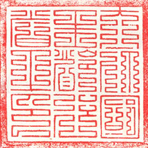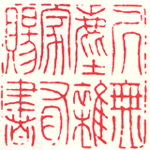Official Seals

Official seal of the Coach Attendant Eastern Han period (25-330)

Official seal with the so-called "nine-fold" script
Official seals have been conferred to officials as a token of their office and authority. These seals were usually small enough to be carried on the official's belt. There were regulations as to the material and shape of the handle of these seals: some had to be golden, some copper, some with a handle in the shape of a turtle, some of a camel. Up to the Eastern Han dynasty (25-330), the color of ink used to affix official seals was regulated depending on the position of the owner, some officials had to use green ink, some purple, some yellow etc.
The calligraphy of the inscription had changed a great deal over the long span of Chinese history. Approaching the Han dynasty, the characters on the seal inscriptions tend to become thicker and more angular. From the Sui dynasty (581-618), they become rounded and thinner, and during the Song and Yuan periods we can witness the spectacular jiudie (nine-folded) script. In the Qing period, most official seals are bilingual with the Chinese inscription on the right side and the Manchu on the left.
Private Seals
Private seals are naturally unregulated; therefore they show the largest variety in content, shape, size, material and calligraphy. Despite their varied characteristics, they can still be categorized based on their use.

Leisure Seal
Seals with names, pen names, pseudonyms etc on them were used as a signature by people in their private life. This is how artists sign their works and letters. Chinese literati commonly used a number of different pen names so identifying a person's name from a seal can be a tricky business.
Collector seals were mainly used for the purpose of authenticating pieces of art. Thus a seal of a famous collector or connoisseur would become an integral part of a work of art and could substantially raise its value. Thus in the course of several centuries, some Chinese paintings became covered by a dozen of different seals.
The rest of private seals can be conveniently categorized under the umbrella term "leisure seals". The inscription on these seals is usually a short text which is either a quote from a famous writing or just some saying that the owner thought important. Typical inscriptions are "Respect fate", "Attain wisdom", "Respect", "Use loyalty and humanity in your affairs" etc. One could compare these seals to signatures with a quote at the end of email messages where the people append some saying they consider valuable at the end of their message.










